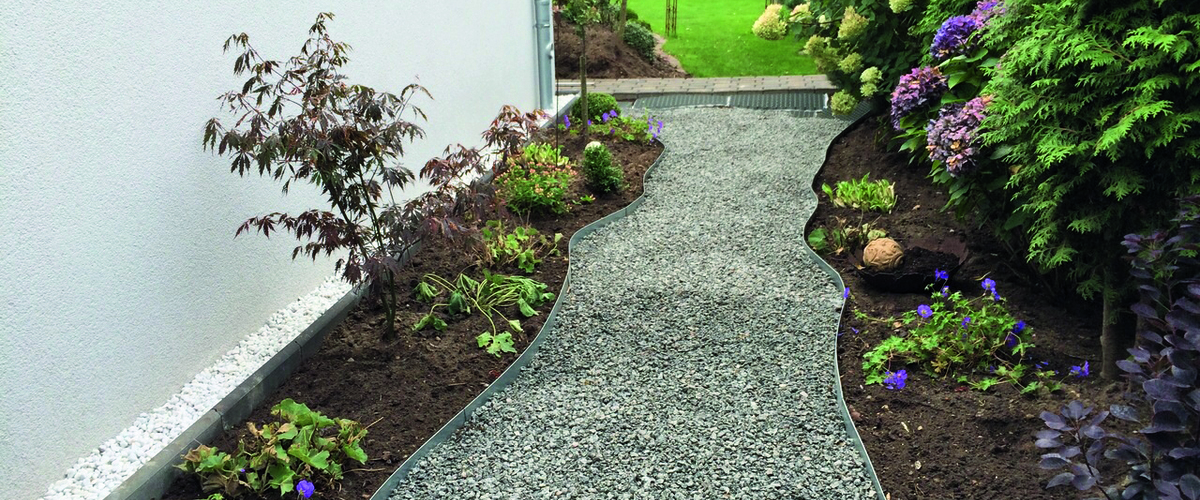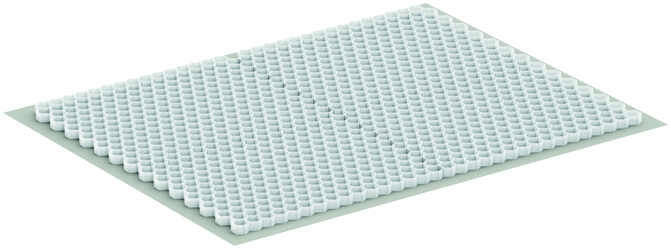.jpg)




Ground Reinforcement with ACO
ACO’s ground reinforcement products facilitate movement across permeable gravel and grass surfaces

.jpg)
Ground reinforcement grids consist of a honeycomb network of plastic cells within a tile that is a convenient size to handle and install. The tiles often interlock for greater stability and have fixing points to anchor the tiles into the sub-base beneath. The cells are then filled with either gravel or soil – if the area is to be planted up with grass.
Why add the additional installation cost of a reinforcement grid when creating graveled or grassed landscaping? There are two significant benefits that justify investing in ground reinforcement grids.
Practical Benefits: reinforcement to reduce damage and allow access


Grass and gravel bring distinct and significant qualities to garden design and enjoyment – the attractiveness of a grass swathe, the satisfying crunch of gravel under foot.
However when grass or gravel surfaces are walked or driven across regularly, they can become marked or rutted. Repeated compaction soon damages grass - the shortcut across the lawn becomes an ugly, muddy footway. Gravel is notorious for scattering or migrating beyond where it is laid and can drift into dips and rises that make the surface uneven. While gravel looks, feels and sounds good underfoot, it can be hard work pushing a pram, wheelbarrow or wheelchair over gravel, let alone riding your bike.
ACO GroundGuard's rigid interlocking cells transfer weight of domestic vehicles and pedestrians direct to the sub-base beneath, protecting grass from damage. ACO GravelGuard in contrast is designed for areas trafficked by pedestrians and cyclists. The honeycomb cells of both products lock gravel in situ, preventing scattering and allow easier access across gravel surfaces.
Environmental Benefits: permeable surfaces reduce rainwater runoff
Hard paving such as block paving, flags and slabs have great benefits in terms easy access, load bearing qualities and low maintenance, hence their popularity in landscaping, not least in front gardens. One in four front gardens are now paved over, with the numbers more than doubling over a decade.* Often this is to park a car off the street, particularly if it is an electric vehicle that needs access to a charging point. However, paving seals over the ground-absorbing soil, increasing the pressure on stormwater drains, which can contribute to sewage overflows into our waterways where there is a combined sewer system.
Grass and gravel surfaces in contrast are fully permeable (but see note below on installation). The honeycomb cells of both ACO GroundGuard and GravelGuard allow rainwater to pass through to the rain-absorbing soil below, as does the geotextile bonded to ACO GravelGuard. Ground reinforcement tiles in conjunction with grass or gravel deliver permeable, accessible and attractive surfaces around homes - plus can fulfil planning requirements.
When a new drive is laid or an existing drive renovated, if the area is over 5m² in England and Wales (0m² in Scotland), rainwater must be dispersed on site and not run into the road or pavement. If you want to put rainwater from a front drive into the storm drain you must apply for planning permission, which is costly and time-consuming. A permeable grass or gravel driveway meets this requirement without the need for planning permission.
.jpg)
Why not get creative as well as environmentally conscious in your garden design? A gravel surface stabilized with ACO GravelGuard can be planted up with pockets of drought-tolerant, low growing plants in-between the trafficked zones, for example between the car tyres or at the edge of a path. Plants should be planted through the ACO GravelGuard into a pocket of soil beneath. Your journey to your front door is then enhanced with attractive and fragrant planting to complement your elegant gravel finish.
Combined with ACO’s ground reinforcement products, grass or gravel copes with foot or vehicle traffic, delivering both a practical and environmental solution.
.jpg)
.jpg)
As with all paving products, careful attention must be given to the layers below the finished surface to ensure the surface can take the weight of traffic across it and remain free-draining.
- Sub-layer: The existing base is dug out to create a smooth and level sub-layer. A stabilization fabric should be laid between the sub-layer and the sub-base.
- Sub-base: Fill the excavated area with free-draining MOT Type 3, compacted in successive layers 70mm deep. A free-draining sub-base such as MOT Type 3 is essential to ensure a higher degree of drainage through the sub-base.
- Laying Course: The area is leveled with a layer of sharp sand and or soil, depending on whether grass is to be sown through the ACO GroundGuard. With ACO Groundguard, a second stabilization fabric should be installed between the sub-base and laying course to prevent the latter settling into the former. If using ACO BorderGuard to secure grid edges, install at this stage.
- ACO Ground Reinforcement Grids: These are then fitted on top of the laying course following the staggered pattern in the installation instructions and pegged if installed on a slope. The grids are then filled with the chosen grass or gravel finish.
The webpages for each product give for full installation instructions and videos.
Check out expert advice from experienced landscaper Rupert Keys on installing ground reinforcement grids. With more than thirty years’ experience, 60 show gardens and the TASK Training Academy to his name, Rupert shares his knowledge, revealing that what goes beneath the grid is as significant as the grid itself to deliver a stable and permeable solution.
.jpg)
ACO GroundGuard (81070)
Tiles of rigid honeycomb cells that transfer the weight of a car or pedestrian direct to the sub-base below, limiting damage to grass growing within its cells. It can also be used to lock gravel in place when it is trafficked by domestic vehicles, for example in driveways.
ACO GravelGuard White (281093) and Grey Eco (281095)
Tiles of flexible honeycomb cells that lock the gravel in place and allows easy access across gravel surfaces for pedestrians and non-vehicular wheeled traffic e.g. pushchairs, wheelbarrows, wheelchairs and bicycles. Its built-in geomembrane prevents gravel sinking into the laying course as it is trafficked and also discourages weed growth. ACO GravelGuard Eco Grey (281095) has the same features as the GravelGuard White (281093), however the tile is made from 100% recycled polypropylene.
ACO BorderGuard (81100)
An edging product used with ground reinforcement tiles and with block paving to create a secure and neat boundary between a reinforced gravel or paved surface and an adjoining boarder or lawn. The open-grid structure allows planting or lawn right up to retaining edge, making the edging almost invisible in contrast to a concrete-haunched edging course.

Accessories for installation
- ACO synthetic nails to secure ACO BorderGuard (81110)
- White parking bay marker inserts for GroundGuard (81072)
- ACO 180mm steel nails to secure all three products (81073)
For further details and for installation videos and instructions, click on the product image above or go to the product's webpage.
*Royal Horticultural Society, Why we all need Greening Grey Britain (2015), p.3
†Rupert Keys' interview reproduced with permission from ProLandscaper Magazine which appeared in the June 2024 edition.
Image of front garden with planting and permeable gravel reproduced with permission from Royal Horticultural Society



